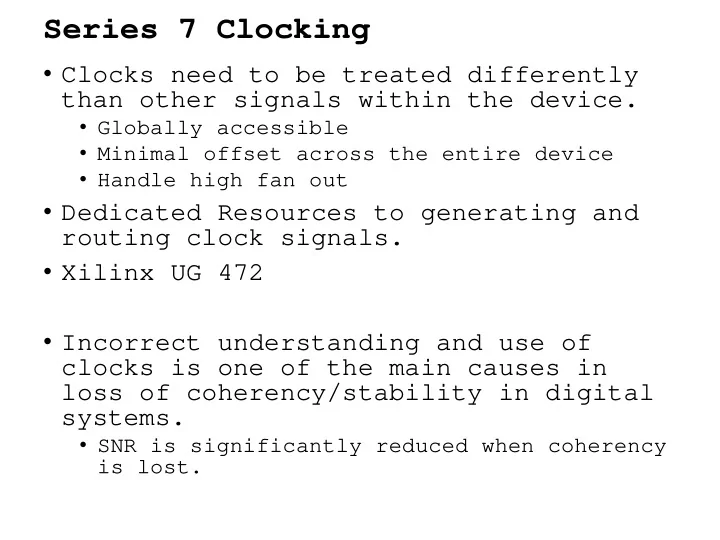

Series 7 Clocking • Clocks need to be treated differently than other signals within the device. • Globally accessible • Minimal offset across the entire device • Handle high fan out • Dedicated Resources to generating and routing clock signals. • Xilinx UG 472 • Incorrect understanding and use of clocks is one of the main causes in loss of coherency/stability in digital systems. • SNR is significantly reduced when coherency is lost.
Clock, Trigger, & Data Routing DAC CLK (64 GHz) DIV-BY-256 REF CLK CLK_IN & SYNC DIV-BY-2 (250 MHz) (125 MHz) TRIGGER IN LATCH LATCH PFI2 (250 MHz) EPRI (125 MHz) CLK CLK MARKER 1 LATCH LATCH PFI0 PRIs at a PRI ADJ factor of (125 MHz) DELAY 125 MHz CLK CLK MARKER 2 LATCH LATCH PFI4 WAVE ID DATA 125/N MHz (125 MHz) BAUD CLK CLK DACs OUT LATCH LATCH AIN 0- π CHIRP 2-Samples N/125 MHz at 125 MHz DURATION CLK CLK (250 MHz)
High Level Clock Architecture • 1 to 24 Clock Regions (Horizontal) • A Clock Region Contains • 50x CLBs per column • 10x 36k Block RAMs • 20x DSP Slices • 12x BUFHs to Route clocks across the horizontal clock region • MMCM and PLL • Mixed-Mode Clock Manager • Phase Locked Loop • BUFG are used to route clocks throughout the entire device.
Buffers • BUFG – Global Clock Buffer • Accessible anywhere in the device. • 1 input and 1 output. • BUFGCE(_1) • Same as BUFG with CE input. • _1: output is one when CE=0. • BUFGCTRL – Global Clk Buf Control • MUXES two clock inputs. • Includes CE’s. • BUFGMUX(_1) • Simple version of BUFGCTRL • BUFMUX_CTRL – same ...
Buffers • BUFH, BUFHCE(_1) • HROW. • Limited to a single clocking region. • BUFIO • Routes clock for IO Resources. • BUFMR, BUFMRCE • Multiple Region. • BUFR • Regional. • Includes ATTRIBUTES for Divider (1-8).
Clock Management Tile • Very Similar • Capability to generate various frequencies and phase offsets between multiple clocks. • Why do we need different clocks. • Decimation • Different timing requirements • DDR, ... • Gigabit Transcievers. • IO serializers and deserializers
MMCM and PLL • Very Similar • Capability to generate various frequencies and phase offsets between multiple clocks. • Why do we need different clocks. • Decimation • Different timing requirements • DDR, ... • Gigabit Transcievers. • IO serializers and deserializers
MMCM and PLL • See clk_mgmt.v
Routing MMCM/PLLs • Basic feedback. • No need for phase alignment on input and outputs.
Routing MMCM/PLLs • Using BUFG(or H) feedback. • Phase Aligned
Routing MMCM/PLLs • Using BUFG(or H) feedback. • Phase Aligned
Clocks for I/O Resources • serializers
Digital Signal Processing ● Most DSP application involve delays, multiplication, accumulation. – Filters – FFT s – I & Q Modulation
DSP48E1 Primitive The Series 7 devices includes a number of DSP48E1 Blocks on the device. • 25-bit pre-adder/subtractor • 25x18-bit multiplier • 48-bit post-adder/subtractor • Delay registers with optional bypasses (set in the configuration bit file)
Inputs ● 4 main data inputs D: 25-bit input to pre-adder/subtractor. – A: 25-bit input to pre-adder/subtractor or direct input to the – multiplier. B: 18-bit input to the multiplier. – C: 48-bit input to the post-adder/subtractor. – ● Other inputs – BCIN: 18-bit carry input to 18-bit pre-adder. PCIN: – 48-bit carry input to 48-bit post-adder. – CIN: 1-bit carry input to 48-bit post-adder. – opmode: 7-bit control for add/subtract and routing.
Outputs – P: main output from 48-bit post-adder. – PCOUT: Same only carry output. – BCOUT: Carry output from 18-bit pre-adder. – MFOUT: 48-bit output from the multiplier. – CCOUT (CFOUT): 1-bit carry output from 48-bit post- adder.
Block Diagram
Block Diagram
FIR Filter Design ● Basic building block of a tapped delay line FIR filter is a delay, multiply, and add sequence. – delay input and output – multiplier with tap weight – accumulator input and output
Block Diagram
Mixer DDS X FIR
SSB DDS X + X DDS
Recommend
More recommend